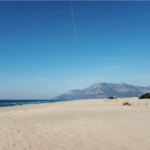Ocean currents move heat around the world and have a major effect on the world’s climate. Nowhere is this clearer than in the North Atlantic Ocean. The Gulf Stream and the Great Ocean Conveyor Belt move huge volumes of warm salty tropical water north to the Greenland coast. Heat from this water helps keep the countries of northwest Europe, which are at the same latitude as Labrador and Greenland, relatively warm.
-
How the Great Ocean Conveyor Belt could cause an Ice Age:
Many scientists, however, are warning that the North Atlantic might cool down, perhaps by the end of the century. Surprisingly, global warming would be the cause. Rising temperatures may not only slow the supply of warm water flowing north, it could disrupt the entire ocean circulation pattern. This scenario could even lead to a new ice age. In this situation, Europe and Canada would become so cold that crops would not grow and glaciers would cover many cities, including London.
There are two major forces making ocean current move. First there is the wind. Because of the Earth’s rotation, the wind causes large circular patterns in the world’s oceans, pushing the water along with it. The second force is related to the density of water. Temperature and salinity affect water’s density. The colder and saltier the water, the denser it becomes. As water becomes denser, it sinks.
The Atlantic Ocean is important in this sinking process. The Gulf Stream and the North Atlantic Current carry warm salty tropical water up into the Greenland Sea. Cold Arctic winds cool this water, increasing its density. The water then sinks, making an underwater current. This same process can be seen in Antarctica and the Mediterranean Sea. Without this process, currents would no longer be created. The global conveyor belt would come to a stop.
Starting off the Greenland coast, the cold deep-water current, slowly moves south along the western side of the bottom of the Atlantic Ocean. It then crosses the equator and most of it spreads north into the Indian and Pacific Oceans where it mixes with warmer water and comes back to the surface.
The surface water then flows from the Pacific and Indian Oceans back into the South Atlantic then heads north. Currents move much of this water north to the equator where the sun heats it even more. Eventually this water enters the North Atlantic, where it keeps Europe warm.
Despite its enormous size, this circulation is vulnerable. If the temperature or salinity in these limited areas changes, the creation of these currents could slow or even stop.
There is strong evidence that the current has stopped in the past, drastically altering the world’s climate in just a matter of years. Eleven thousand years ago, ice age glaciers were melting and the world was getting warmer. The last ice age was ending. In central Canada, an immense glacial lake called Lake Agassiz, which was larger than all the Great Lakes if the United States, was created by the melting ice. Suddenly the lake holding Lake Agassiz overflowed. The water of the entire lake rushed into the North Atlantic along the St. Lawrence River. This massive amount of fresh water made the Atlantic much less salty and the sea water was no longer dense enough to sink. The Great Ocean Conveyor Belt came to a stop. A cold period called the Younger Dryas started and the ice age returned or another thousand years.
We may soon face a similar situation. Scientists are predicting that rising temperatures will melt the Greenland ice sheet. Models suggest that the resulting influx of fresh melt water into the polar sea could stop the Great Ocean Conveyor Belt. Temperatures over northwestern Europe could drop dramatically.
-
International travel insight: Will global warming trigger a new ice age?
If you can remember back to the bitter winters of the late 1970s and early 80s you might also recall that there was much discussion in scientific circles at the time about whether or not the freezing winter conditions were a portent of a new ice age.
According to Bill McGuire, over the past couple of decades such warnings have been drowned out by the great global warming debate and by consideration of how society might cope in future with a sweltering planet rather than an icebound one. Seemingly, the fact that we are still within an interglacial period, during which the ice has largely retreated to its polar fastnesses, has been forgotten – and replaced with the commonly-held view that one good thing you can say about global warming is that it will at least stave off the return of the glaciers.
Is this really true, or could the rapidly accelerating warming that we are experiencing actually hasten the onset of a new ice age? A growing body of evidence suggests that, at least for the UK and western Europe, there is a serious risk of this happening – and soon.
The problem lies with the ocean current known as the Gulf Stream, which bathes the UK and north-west Europe in warm water carried northwards from the Caribbean. It is the Gulf Stream, and associated currents, that allow strawberries to thrive along the Norwegian coast, while at comparable latitudes in Greenland glaciers wind their way right down to sea level. The same currents permit palms to flourish in Cornwall and the Hebrides, whereas across the ocean in Labrador, even temperate vegetation struggles to survive. Without the Gulf Stream, temperatures in the UK and north-west Europe would be five degrees centigrade or so cooler, with bitter winters at least as fierce as those of the so-called Little Ice Age in the 17th to 19th centuries.
The Gulf Stream is part of a more complex system of currents known by a number of different names, of which the rather cumbersome North Atlantic Meridional Overturning Circulation (Namoc) is probably the most apt. This incorporates not only the Gulf Stream but also the cold return currents that convey water southwards again. As it approaches the Arctic, the Gulf Stream loses heat and part of it heads back to warmer climes along the coast of Greenland and eastern Canada in the form of the cold, iceberg-laden current responsible for the loss of the Titanic. Much, however, overturns – cooling and sinking beneath the Nordic seas between Norway and Greenland, before heading south again deep below the surface.
“In the past, the slowing of the Gulf Stream has been intimately linked with dramatic regional cooling. Just 10,000 years ago, during a climatic cold snap known as the Younger Dryas, the current was severely weakened, causing northern European temperatures to fall by as much as 10 degrees. Ten thousand years before that, at the height of the last ice age, when most of the UK was reduced to a frozen wasteland, the Gulf Stream had just two-thirds of the strength it has now.”











